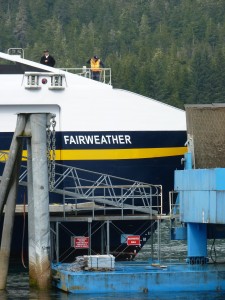
State transportation officials plan to take four of Alaska’s 11 ferries out of service next summer due to budget cuts.
People who use the Alaska Marine Highway System ferries will have longer travel times and less service next year under a proposed summer schedule released by the state this week. The Marine Highway is proposing to keep the state’s two fast catamarans tied up next year along with two other, older vessels. That will mean fewer stops in some coastal communities.
It was a just a decade ago, the newest and fastest ships for the marine highway fleet docked at Petersburg’s terminal, offering ferry connections to Juneau and Ketchikan in half the time of the older slower ships. The Fairweather and Chenega burn more fuel than slower older mono-hulls and they’ve already had their engines replaced. This winter they’re scheduled to get five million dollars worth of new paint, carpeting, floor coatings, upholstery and other work at a Seattle shipyard. DOT spokesman Jeremy Woodrow says the ships will remain tied up under the proposed schedule.
“I think indefinitely is the way to go. It’s really funding available. When managers were looking at how the system could maximize ferry service within the proposed budget, this was the best way to continue to provide service to Alaskans and visitors without cutting off any communities and still maintaining still some sort of schedule where there would be consistent service to communities.”
In recent summers, the fast ferries have been providing service in the summertime in Sitka, Juneau, Angoon and Petersburg along with Cordova, Whittier and Valdez. The schedule also proposes to keep two slower boats, the Taku and Malaspina out of service for the summer. Woodrow says the decision is a financial one.
“It’s been well noted the state has seen a budget gap due to low oil prices. And it’s expected that all state departments are going to be working with reduced operating budgets, the marine highway system being no different. And so the proposed schedule is reflecting the idea that we will have a lesser operating budget for 2016.”
No towns are losing the state ferry entirely, but there are some service reductions under the proposed schedule. Woodrow says one example is in Lynn Canal.
“Normally the Malaspina would run as a day boat between Juneau, Haines and Skagway. The proposed schedule has the Malaspina as we mentioned in layup and overhaul during the summer. What this does is it puts the LeConte in what we call the northern panhandle route which the LeConte will now be serving Lynn Canal as well as the Chatham and Icy Strait communities. What that essentially does is it takes seven days a week service and it turns it into five days a week service.”
The plan has the Kennicott running from Bellingham, Washington, through Southeast Alaska and across the gulf May through August. That vessel would end cross gulf service one month early in September and would take over service between Prince Rupert British Columbia and Southeast Alaska. That allows the Kennicott to fill in for the Matanuska, which is scheduled for work starting in September. The proposed schedule has the Aurora providing service to Cordova, Valdez and Whittier in the summer months, but ending that service in late September for a scheduled overhaul. That leaves a gap in service in Prince William Sound for a month and a half.
Woodrow acknowledges other gaps could come if ships have mechanical problems.
“With less vessels operating, if there are mechanical breakdowns there is less opportunity to backfill or fill in for those boats with other vessels. So there may be gaps in service if there are any major breakdowns.”
That happened this past summer when the system’s largest vessel, the Columbia was out of service for the second half of August undergoing repairs. Ships deployed elsewhere in the region filled in for the Columbia during that busy summer month.
Petersburg area resident Dave Kensinger relies on the ferry for his produce business and has proposed big changes to the way the ferry system operates.
He thinks the level of service proposed in the summer schedule is worse than what residents had with private steamships prior to the start of the ferry system.
“It’s that bad. I think this is a day that I have been worried about and, unfortunately, it’s now happened. And I think it’s time for the people that use the ferry system and the residents of Southeast Alaska to realize DOT does not have the answers and we need to do something different.”
Kensinger thinks the Marine Highway is going to have to look at eliminating service to communities that have road access and focus on serving island towns only.
“The community of Sitka is going to get one northbound ferry a week and one southbound ferry a week. I mean if you don’t have enough assets or you don’t have enough money to provide service you should put your priority to people who don’t have any road access whatsoever.”
The schedule for next summer is not finalized yet. The state is taking public comment through November 3rd and will be holding teleconferences on November 4th. Meanwhile, the start of bookings for the summer season is behind schedule. That’s because of a delay in getting the fall and winter schedule finished, along with the transition to a new reservation system.
The marine highway hopes to be able to start taking summer bookings starting in December with phone reservations, and online bookings soon after.